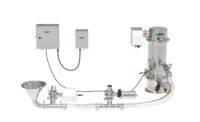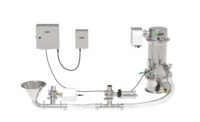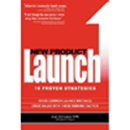Bakers and snack manufacturers are well-acquainted with the adage, “Time is money.” Equipment failure, maintenance and sanitation have always resulted in costly downtime. Frequent equipment changeovers often contribute to this issue, as food producers add to or expand their product offerings in response to consumer trends.
“Today’s baker is all about flexibility,” says Rick Hoskins, director of sales and marketing, Colborne Foodbotics, LLC, a Lake Forest, Ill.-based company that offers automated systems for food processing and packaging. “Running multiple stock-keeping units (SKUs) on a given line is imperative. Changeover is treated as downtime, and downtime costs bakers significant amounts of labor and opportunity cost.”
The key to reducing the negative impacts of changeover is speed, say manufacturers of food-processing and packaging equipment. “Quicker changeover times allow manufacturers to maximize production uptime, providing a faster return on their equipment cost and lowering product costs, all of which contribute to an improved bottom line for higher profits,” says Kevin Pearson, vice president of Arr-Tech Inc., a Yakima, Wash.-based company that provides automated counting and stacking machines to the tortilla, pizza and flatbread industries.
Dominque R. Kull, manager, bakery supply systems, for Bühler Inc., Plymouth, Minn., agrees that reducing changeover time increases equipment uptime. “This, in effect, increases production capabilities and efficiency,” she says. Bühler is a specialist and technology partner for plant, equipment and related services for processing basic foods and manufacturing high-grade materials.
Quicker changeover times result in less overhead labor, or labor not used to manufacture products, says John Kadinger, marketing manager of Key Technology in Walla Walla, Wash. “It also improves overall equipment effectiveness (OEE) due to less downtime,” he explains. “Reducing overhead labor and improving OEE both improve the plant’s bottom line.” To this end, Key Technology supplies snack producers with optical sorters and specialized conveying equipment.
Don Osborne, team leader at Intralox L.L.C. U.S.A., a global conveyance solutions and services provider based in Hanrahan, La., adds that quicker changeover cycles enable bakers and snack producers to convert reduced changeover time to production time. “Changing an hour of changeover time to production time when you’re running at capacity is a huge deal,” he says.
Make a plan
There are numerous ways for food processors to speed up their changeover cycles. “Plan, anticipate and be ready to react,” says Kadinger, when asked what bakers and snack producers can do to reduce their equipment changeover cycle times. “It seems obvious that there needs to be a plan, but it’s more than just identifying what needs to be done, who needs to do it and how long it will take. The planner needs to identify the critical path or those activities that, if delayed, impact other activities.
“The processor needs to anticipate something not going exactly as planned, especially for the higher risk activities, and have a plan B ready in case something does happen that impacts the schedule.”
Using equipment designed to facilitate changeover is important, too. For instance, every vibratory conveyor within Key Technology’s Smart Shaker family—Iso-Flo, Impulse and Horizon—is designed with sanitation in mind to maximize product quality and ease changeover, according to Kadinger. The company offers these conveyors with various finishes on the stainless-steel beds, so each system is appropriate for the product application and facilitates quick cleaning and changeover.
New features include redesigned screen clamps that require no tools to speed changeover and lighter screens to improve operator ergonomics during changeover.
Used to feed scale systems, Key’s Impulse and Horizon conveyors can be tuned to various products and integrated with a control system for streamlining changeovers and maximizing OEE. The company’s belt conveyors are designed for quick belt changeovers and have an open, sanitary design for cleaning.
Snack producers use Key Technology’s digital sorting systems to remove foreign material and defects from products. To ease operation and speed changeovers, they feature Key’s application-specific KeyWare software, which provides a user interface in terms that are common to the application and enables the customer to save each product’s settings. KeyWare enables an operator to changeover a sorter in less than five minutes by simply recalling the product recipe from memory on the touchscreen control panel.
Intralox’s Osborne says the first thing bakers and snack producers can do to reduce their changeover cycle times is “pretty obvious, and that’s just to run the product longer. Then, you’ll get longer run time.
“Secondly, automate the machine setups to reduce manpower. An example would be a bakery that has different pans for making different products. A lot of times, the pans are different sizes—sometimes they’re 13 in. wide, sometimes they’re 20 in. wide. When you change from pan to pan, you have to adjust the guides on the conveyors to accommodate those pans. If those adjustments are done automatically with the touch of a button, then you can do that a lot faster and make the changeovers faster.”
Lastly, Osborne recommends bakers and snack producers use clean-in-place (CIP) systems to shorten cleaning time and use less manpower for product changeovers. “CIPs are very important when it comes to allergens as well,” he adds.
Intralox’s ThermoDrive belt, which combines the best features of modular plastic and traditional flat belts, can reduce cleaning time in snack plants to less than 20 minutes, from 60 minutes using old technology, according to Osborne. The belt is homogeneous thermoplastic with 100% closed surfaces, and unlike traditional flat belts, drives on sprockets like modular plastic belts and is easy to lift for conveyor cleaning.
Keep it simple
Some steps bakers and snack producers can take to reduce equipment changeover times are “relatively simple to enact,” says Steve Burgess, operations manager for tna Europe, Birmingham, U.K. “First, it is necessary to set up a single control system and integrate it into the whole production line. This ensures that operators must only set up the necessary processes from a single point, saving time and leaving less room for error. With an effective control system, it is possible to arrange automatic setup and control of product programs, making it even easier to use and change from one product to another.”
Sydney-based tna, a global supplier of integrated food-packaging solutions, recently acquired The Cadalec Group, specialists in electrical and control system integration, to enhance its controls and automation capabilities. “Tna’s control systems are easy to integrate within existing production lines and will help to facilitate programming to reduce changeover times,” Burgess says. “The user-friendly digital touchscreen and settings offer easy accessibility for operators and can store up to 1,000 programs.”
In addition to a single control system, Burgess says simplified equipment with fewer removable parts and easy-to-clean surfaces can also aid product changeover because it requires little cleaning between product runs. Potato chip manufacturers can switch from processing one flavor to another, for instance, without prolonged downtime.
Tna’s robag vertical form/fill/seal (VFFS) bagger, a quick-change, lightweight former and single-pass film-loading system delivers “complete flexibility,” says Burgess. “No mechanical adjustments are needed when changing product or film, so manufacturers can switch between different bag types with ease and accelerate changeovers. What’s more, with our ‘sophisticated simplicity’ design, our equipment is made with easy-to-clean surfaces and fewer welded parts to eliminate product buildup and meet Hazardous Analysis and Critical Control Points (HACCP) regulation.”
Training workers also is essential to maximizing a company’s skill set and improving processes, Burgess adds.
Pearson, too, cites proper employee training of changeover procedures and employee awareness of time schedules as contributors to faster changeover times. The latter, he says, enables workers involved in changeovers to coordinate their efforts to minimize downtime.
Like other equipment manufacturers, Pearson recommends bakers and snack producers invest in quality systems designed for quick and easy changeovers. “With more than 30 years of experience developing, designing and manufacturing automated packaging systems and of listening to our customers’ suggestions, [Arr-Tech’s] goal is to always deliver the highest quality automated packaging systems designed specifically to meet their needs,” he explains. “Our systems are specifically designed with minimal changeover parts and do not to require tools for equipment changeover. Arr-Tech changeover parts can easily be adjusted or removed and installed by hand, typically requiring only one to two people to make any changeover adjustments.”
In addition, a color touchscreen provides detailed graphic images with easy-to-understand views of adjustments and timers for the entire line of equipment and provides up to 50 product recipe selections. The operator enters the product name or code and pre-defined settings are automatically loaded from memory. “In most cases, the average product changeover time for Arr-Tech equipment is less than a few minutes,” Pearson adds.
As they like it
Intelligent production scheduling allows bakers to run more production cycles without major cleaning in between, says Kull. “For example, start with a light-colored product and move to recipes with darker products or go from nonallergen to allergen products,” she explains. “Today, there are also software solutions that set up rules and coordinate to the most efficient production schedule.”
Kull adds that designing the process flow in the first stage of production to eliminate the need for cleanout wherever possible also helps reduce changeover time.
Bühler’s Plant Automation solution features a core module to which other modules can be added, enabling users to create a customized system that meets their needs. Modules for production planning—production optimization, silo management, traceability and warehouse handing—can be combined to help reduce downtime.
“Our equipment is designed to eliminate any residues in machines and in the process,” Kull explains. “[For instance], our latest blender/dry mixer ensures no product residues are caught on uneven surfaces or on gaps.”
Colborne Foodbotics, meanwhile, offers a variety of optional, automatic tool-change features for its robotic automation systems that allow bakers to change over the tooling with the push of a button. “Depending on the system, we have tool holders that are mounted within the safety confines of the automatic cell or, for larger tools, we have portable carts that operators wheel in and out of a cell for the changeover process,” explains Hoskins.
In addition to optional modules and tools, portable equipment can help bakers and snack manufacturers speed up their changeover cycles, especially at the sheeting and makeup stages. “[Investing in] portable equipment that’s independent of the system and can be easily rolled in and out is definitely one thing that bakers can do to make their systems more flexible,” says David Moline, sales and marketing manager for Moline Machinery, LLC, a Duluth, Minn.-based manufacturer of industrial baking equipment, including dough sheeting and make-up lines and high-capacity donut systems.
Moline cites the company’s side-loading duster-dispensers as an example. “Moline side load dusters can be used for a wide variety of things—flour, dry toppings, cinnamon,” he explains. “A baker can pull it to the side [of a sheeter], empty the hopper, quickly refill it and get back into production to make an entirely different product.” The units can be outfitted with quick-release handles and are designed to be changed over quickly without tools.
Like other equipment manufacturers, Moline says CIP systems and controllers with recipe storage can help food processing reduce their changeover times. “The faster you can turn a piece of equipment around for sanitation—get rid of any allergens—the faster it can be put back into production,” he says.
While equipment that’s right for the job and designed to facilitate quick changeovers is key to reducing downtime, an effective changeover plan and well-trained employees are just some additional steps bakers and snack producers can take to keep their lines up and running smoothly.










